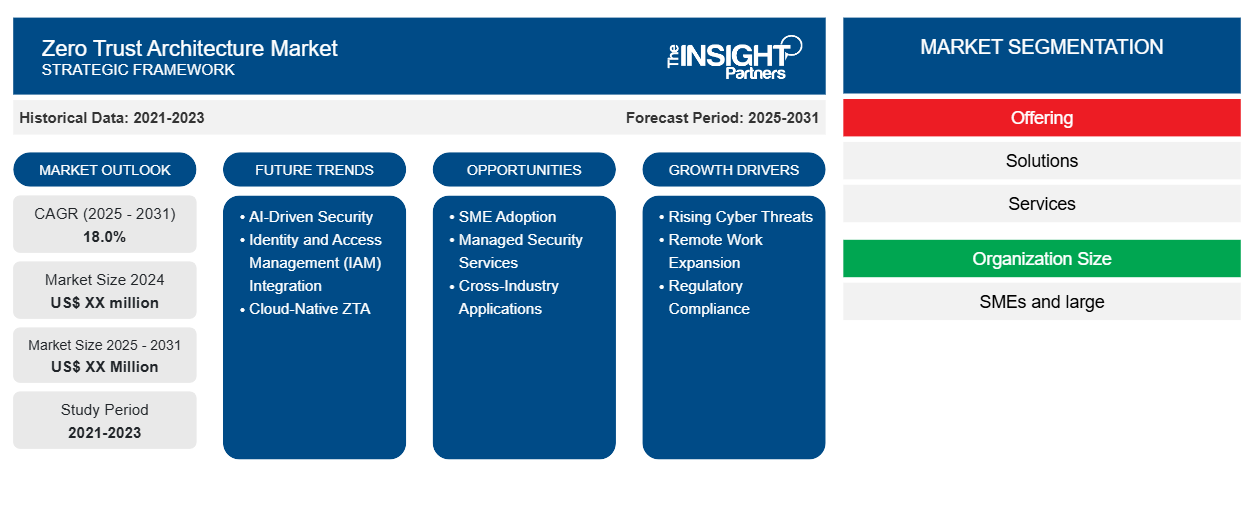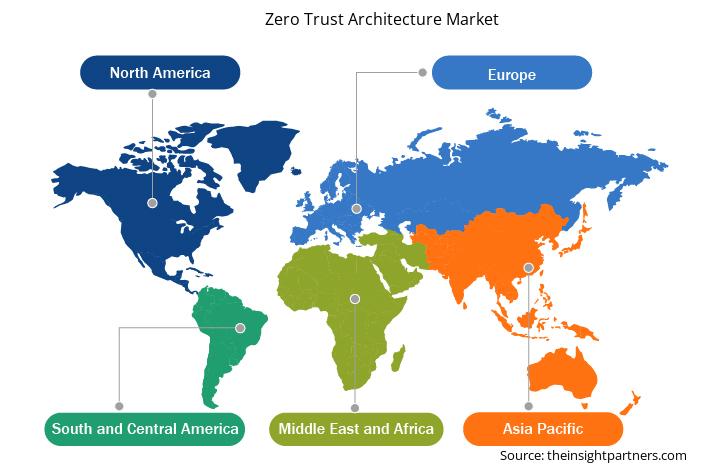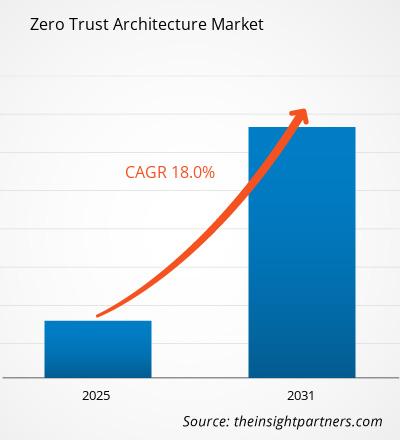Si prevede che il mercato dell'architettura Zero Trust registrerà un CAGR del 18,0% dal 2024 al 2034, con una dimensione di mercato in espansione da XX milioni di dollari USA nel 2024 a XX milioni di dollari USA entro il 2031.
Il report è segmentato per Offerta (Soluzioni, Servizi); per Dimensione dell'Organizzazione (PMI e grandi); per Distribuzione (Cloud e On-Premise) e per Verticale (Elettronica di Consumo, IT e Telecomunicazioni, Automotive, Manifatturiero, Edilizia e Costruzioni, Sanità e Dispositivi Medici, Altri). L'analisi globale è ulteriormente suddivisa a livello regionale e per i principali Paesi. Il report fornisce i valori in USD per l'analisi e i segmenti sopra indicati.
Scopo del rapporto
Il rapporto "Zero Trust Architecture Market" di The Insight Partners mira a descrivere il panorama attuale e la crescita futura, i principali fattori trainanti, le sfide e le opportunità. Questo fornirà spunti di riflessione a diversi stakeholder aziendali, tra cui:
- Fornitori/produttori di tecnologia: per comprendere le dinamiche di mercato in evoluzione e conoscere le potenziali opportunità di crescita, consentendo loro di prendere decisioni strategiche informate.
- Investitori: condurre un'analisi completa delle tendenze in merito al tasso di crescita del mercato, alle proiezioni finanziarie del mercato e alle opportunità esistenti lungo la catena del valore.
- Enti di regolamentazione: regolamentano le politiche e le attività di polizia nel mercato allo scopo di ridurre al minimo gli abusi, preservare la fiducia degli investitori e sostenere l'integrità e la stabilità del mercato.
Segmentazione del mercato dell'architettura Zero Trust
Offerta
- Soluzioni
- Servizi
Dimensione dell'organizzazione
- PMI e grandi
Distribuzione
- Cloud e on-premise
Verticale
- Elettronica di consumo
- IT e telecomunicazioni
- Automobilistico
- Produzione
- Costruzione e edilizia
- Assistenza sanitaria e dispositivi medici
- Altri .
Personalizza questo report in base alle tue esigenze
Riceverai la personalizzazione gratuita di qualsiasi report, incluse parti di questo report, analisi a livello nazionale, pacchetto dati Excel e potrai usufruire di fantastiche offerte e sconti per start-up e università.
Mercato dell'architettura Zero Trust: approfondimenti strategici

- Scopri le principali tendenze di mercato di questo rapporto.Questo campione GRATUITO includerà analisi di dati che spaziano dalle tendenze di mercato alle stime e alle previsioni.
Fattori di crescita del mercato dell'architettura Zero Trust
- Crescenti minacce informatiche: attacchi informatici sempre più sofisticati, tra cui ransomware e violazioni dei dati, accrescono la domanda di un'architettura Zero Trust (ZTA) per garantire una sicurezza solida e continua su tutte le reti.
- Espansione del lavoro da remoto: il passaggio ad ambienti di lavoro remoti e ibridi aumenta l'esigenza di ZTA, garantendo un accesso sicuro per utenti e dispositivi al di fuori del perimetro della rete aziendale.
- Conformità normativa: normative più severe, come GDPR e CCPA, spingono le organizzazioni ad adottare ZTA per soddisfare gli standard di sicurezza e proteggere i dati sensibili.
Architettura Zero Trust: tendenze future del mercato
- Sicurezza basata sull'intelligenza artificiale: l'integrazione dell'intelligenza artificiale e dell'apprendimento automatico in ZTA migliorerà il rilevamento delle minacce, consentendo una valutazione dei rischi in tempo reale e risposte di sicurezza automatizzate.
- Integrazione con la gestione delle identità e degli accessi (IAM): ZTA si evolverà per integrarsi strettamente con le soluzioni IAM, garantendo un controllo più granulare sull'accesso degli utenti e un'autenticazione continua.
- ZTA cloud-native: con la crescita dell'adozione del cloud, aumenterà anche la domanda di framework Zero Trust cloud-native, garantendo la sicurezza negli ambienti distribuiti e multi-cloud.
Opportunità di mercato dell'architettura Zero Trust
- Adozione da parte delle PMI: le piccole e medie imprese (PMI) stanno adottando sempre più modelli Zero Trust, creando l'opportunità di soluzioni ZTA convenienti e scalabili, su misura per le loro esigenze.
- Servizi di sicurezza gestiti: offrire ZTA come parte dei servizi di sicurezza gestiti consente ai provider di soddisfare la domanda del mercato, in particolare delle organizzazioni prive di competenze interne in materia di sicurezza informatica.
- Applicazioni intersettoriali: la flessibilità di ZTA offre l'opportunità di implementarlo in vari settori, come sanità, finanza e pubblica amministrazione, ognuno con requisiti di sicurezza specifici.
Approfondimenti regionali sul mercato dell'architettura Zero Trust
Le tendenze e i fattori regionali che influenzano il mercato dell'architettura Zero Trust durante il periodo di previsione sono stati ampiamente illustrati dagli analisti di Insight Partners. Questa sezione illustra anche i segmenti e la geografia del mercato dell'architettura Zero Trust in Nord America, Europa, Asia-Pacifico, Medio Oriente e Africa, e America Meridionale e Centrale.

- Ottieni i dati specifici regionali per il mercato dell'architettura Zero Trust
Ambito del rapporto di mercato sull'architettura Zero Trust
| Attributo del report | Dettagli |
|---|---|
| Dimensioni del mercato nel 2024 | XX milioni di dollari USA |
| Dimensioni del mercato entro il 2031 | XX milioni di dollari USA |
| CAGR globale (2025-2031) | 18,0% |
| Dati storici | 2021-2023 |
| Periodo di previsione | 2025-2031 |
| Segmenti coperti | Offrendo
|
| Regioni e paesi coperti | America del Nord
|
| Leader di mercato e profili aziendali chiave |
|
Densità degli attori del mercato dell'architettura Zero Trust: comprendere il suo impatto sulle dinamiche aziendali
Il mercato dell'architettura Zero Trust è in rapida crescita, trainato dalla crescente domanda degli utenti finali, dovuta a fattori quali l'evoluzione delle preferenze dei consumatori, i progressi tecnologici e una maggiore consapevolezza dei vantaggi del prodotto. Con l'aumento della domanda, le aziende stanno ampliando la propria offerta, innovando per soddisfare le esigenze dei consumatori e sfruttando le tendenze emergenti, alimentando ulteriormente la crescita del mercato.
La densità degli operatori di mercato si riferisce alla distribuzione delle imprese che operano in un determinato mercato o settore. Indica quanti concorrenti (operatori di mercato) sono presenti in un determinato spazio di mercato in relazione alle sue dimensioni o al suo valore totale.
Le principali aziende che operano nel mercato dell'architettura Zero Trust sono:
- Palo Alto Networks
- VMware
- Zscaler
- Akamai
- Microsoft
- Cisco
Disclaimer : le aziende elencate sopra non sono classificate secondo alcun ordine particolare.

- Ottieni una panoramica dei principali attori del mercato dell'architettura Zero Trust
Punti di forza chiave
- Copertura completa: il rapporto affronta in modo esaustivo l'analisi dei prodotti, dei servizi, delle tipologie e degli utenti finali del mercato dell'architettura Zero Trust, fornendo una panoramica olistica.
- Analisi degli esperti: il rapporto è compilato sulla base della conoscenza approfondita di esperti e analisti del settore.
- Informazioni aggiornate: il rapporto garantisce la pertinenza aziendale grazie alla copertura di informazioni recenti e tendenze nei dati.
- Opzioni di personalizzazione: questo report può essere personalizzato per soddisfare le esigenze specifiche del cliente e adattarsi in modo appropriato alle strategie aziendali.
Il rapporto di ricerca sul mercato dell'architettura Zero Trust può quindi contribuire a tracciare un percorso di decodificazione e comprensione dello scenario e delle prospettive di crescita del settore. Sebbene possano esserci alcune valide preoccupazioni, i vantaggi complessivi di questo rapporto tendono a superare gli svantaggi.
- Analisi storica (2 anni), anno base, previsione (7 anni) con CAGR
- Analisi PEST e SWOT
- Valore/volume delle dimensioni del mercato - Globale, Regionale, Nazionale
- Industria e panorama competitivo
- Set di dati Excel
Report recenti
Testimonianze
Motivo dell'acquisto
- Processo decisionale informato
- Comprensione delle dinamiche di mercato
- Analisi competitiva
- Analisi dei clienti
- Previsioni di mercato
- Mitigazione del rischio
- Pianificazione strategica
- Giustificazione degli investimenti
- Identificazione dei mercati emergenti
- Miglioramento delle strategie di marketing
- Aumento dell'efficienza operativa
- Allineamento alle tendenze normative




















 Ottieni un campione gratuito per - Mercato dell'architettura Zero Trust
Ottieni un campione gratuito per - Mercato dell'architettura Zero Trust